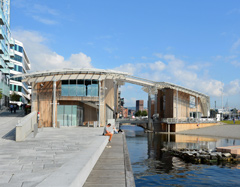 |
RPBW was commissioned to build a new home for the permanent collection of the Astrup Fearnley Museum, a separate space for its temporary exhibitions, and an office building with its own exhibition area for a private art collection. Three timber-clad buildings shelter under a single swooping glass roof in a newly landscaped public sculpture garden.
A tour of the museum takes the visitor on a journey through ten rooms and includes all three buildings. The Art Museum, on the north side of the canal that cuts through the middle of the site, houses the Astrup Fearnley’s permanent collection of contemporary art. This building connects at ground level underneath the main stair and piazza on Tjuvholmen Allee, into the ground floor of the adjacent office building, where a private art collection is displayed.
To the south, over a footbridge across the canal, is the museum’s space for temporary exhibitions. Gallery space is spread over two floors, giving the visitor a diverse range of spaces and volumes to experience, shaped by the curve of the sloping roof and lit via a spectacular skylight. An exterior roof terrace at second floor level provides a generous exhibition space for sculpture.
The four-storey office building is arranged around a central, day-lit atrium. Conference rooms and terraces on the upper floors take advantage of the spectacular views.
The landscaping of the surroundings was an integral part of the project. A promenade along the waterfront links Tjuvholmen back to the city centre. The cafe, a beach for swimming, and the sculpture park are all designed to attract a diverse range of visitors and create a truly public space.
One of the most prominent elements of this project is the huge glass roof that soars over the complex, linking the buildings together and giving the development a presence on the waterfront. Its curved shape, formed by laminated wood beams, crosses the canal between the buildings. The beams are supported by slender steel columns, reinforced with cable rigging, which refer to the maritime character of the site. On Skjaeret, the roof almost touches the ground. A small pond prevents people from climbing on the glass.
The glass on the roof has a white ceramic frit, reducing its transparency by 40%. On the facades, wherever possible, low-iron glass has been used to enhance transparency and to minimize the discoloration of the light into the exhibition spaces.
The museum opened to the public on september 29, 2012.
RPBW




